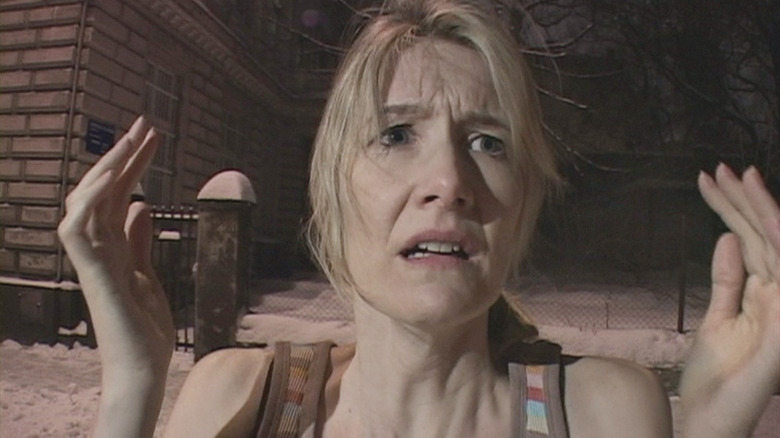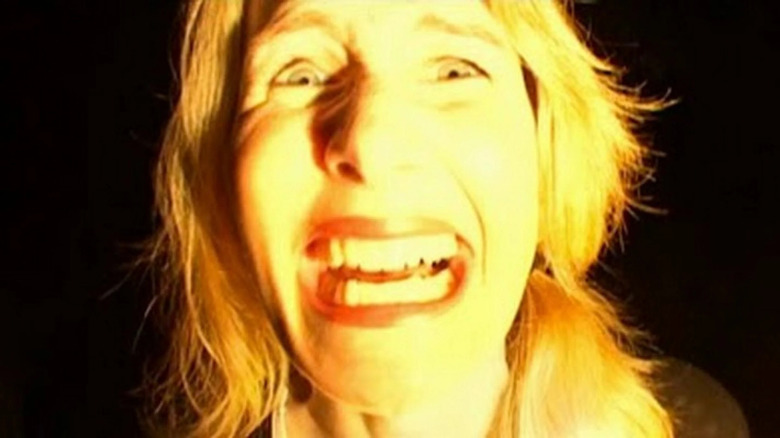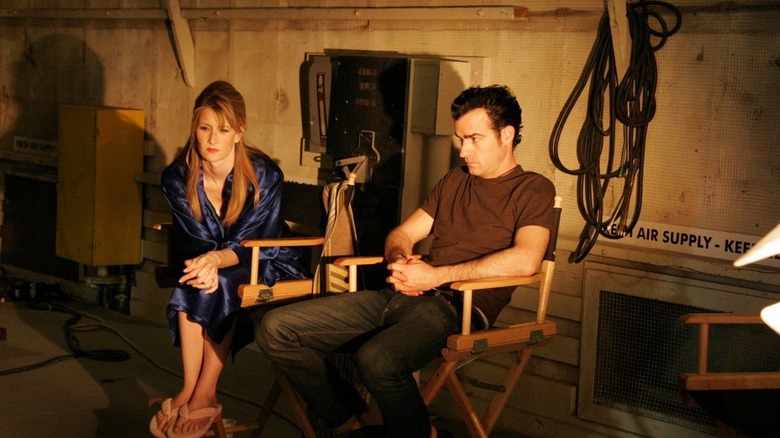Why David Lynch Chose To Shoot Inland Empire Digitally
In the early 2010s, the bulk of America's theaters switched to digital projection, and many film purists lamented the change. In 2012, documentarian Chris Keneally released "Side by Side," a film in which famous filmmakers and photographers are interviewed about the pros and cons of digital film vs. celluloid. Some of them argue that digital photography will never match the visual heft and classical tambours of good old-fashioned 35mm film strips. Others embrace the change or are egalitarian, saying that any tool should be added to a filmmaker's toolbox. Others still are openly reticent, preferring to stick to film, thank you very much. Big-name directors like Christopher Nolan have since continued to advocate for the older tech.
A surprising fan of digital cameras is David Lynch, whose films prior to 2006's "Inland Empire" feature rich, dark, beautiful photography that would not have been possible on the digital cameras of 2012. In "Side by Side," David Lynch calls film a "dinosaur," and points out to the film's host, Keanu Reeves, that "When that thing starts rolling, there's an underlying feeling that there's precious stuff rolling through there." This was antithetical to organic acting as, Lynch argues. "It puts a kind of tension on things." With a constantly-running digital camera, Lynch finds he can give direction without having to cut, and roll out 40 full minutes without having to worry about wasting film.
A decade later, in 2022, Lynch's view on digital film hadn't changed. In an interview with IndieWire, the filmmaker elucidated on how digital film was, by his estimation, more conducive to his creative process.
Fast and lightweight
David Lynch shot "Inland Empire" in a very unconventional way, writing the script as shooting went. He would think up an idea one morning, call up a very game Laura Dern, ask her over to his house or some other shooting location, and the two would work out a scene together. Much of the movie was shot without a story or a unifying principle in mind. In order to work this way, Lynch required a lightweight digital camera. 35mm would have taken too long to shoot, light, develop, and review. With digital, he could shoot and play it back instantly. When IndieWire asked him why he preferred digital, Lynch explained:
"It was so lightweight and fast. Small lights, lightweight camera, long takes — those three things right there change everything. Of course, now you've got digital cameras that are giant with lenses that weigh 50,000 pounds and you're back in the old world, with a long time to wait for lighting. But there are also smaller and smaller cameras that have more and more features — better automatic focus, more steadying gizmos."
In short, all the things a filmmaker longs for when it comes to streamlining the filming process, Lynch was granted in spades. Additionally, because digital cameras are so small, they can fit on a drone, a feature Lynch loves. The old days of needing entire helicopters to hoist a giant 35mm camera off the ground are at an end. "And now," he added, "there are drones that can do things you could never do before. Forget helicopters." Lynch has yet to shoot anything using drone cameras, but we can perhaps assume that he was a big fan of "Ambulance" and "The Gray Man" (both of which feature action scenes partly shot using drones).
The magic of drones
It seemed that, after the release of "Inland Empire," David Lynch was all set to retire. He ran his own video blog, giving daily weather reports and talking about the day, and he released albums in 2011 and 2013 titled "Crazy Clown Time" and "The Big Dream," each one jazz and poetry inflected. His filmmaking days appeared to be behind him. Surprisingly, in 2017, Lynch released an entire new season of his hit 1990 TV series "Twin Peaks" for Showtime, dubbing it "Twin Peaks: The Return." The filmmaker co-wrote and directed all 18 episodes of "The Return," all of them filmed digitally. Despite his stated enthusiasm for drones, none of "The Return" was shot with them.
Clearly, however, the man has played around with them. He told IndieWire:
"You can grab the drone and move with it yourself, and then at a certain time let it go and soar around and then run after it and catch it and go back inside — you have these long shots that are incredible. And with the actors, I can get right in there with them and talk to them and watch them and move with them in a way that I never could before."
The director seemed eager to describe camera movements to IndieWire and made no mention of the look of digital film. In 2006, digital photography (in this author's opinion) looked "tinny" and washed out, with bland colors and movements possessing "trails." In 2022, digital cameras have markedly improved, and Lynch might very well shoot a new feature on smaller cameras (just the way he likes) while retaining the cinematic quality of his early work.
Should he decide to, that is.


